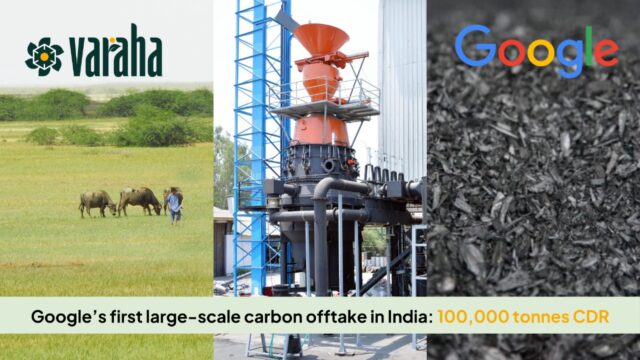With huge amounts of data gathered for research in the agriculture sector, experts are making good usage of analytics to ensure that today’s farmer gets every tech advantage.
Technology intervention has a pivotal role in modern agriculture. Consequently, humungous data is on the plate of agtech researchers and practitioners for churning and deciphering agricultural complexities.
Read more: Advantage Agtech: Moving towards online tech-based platforms
In India, high penetration of mobile handsets, large number of potential users, rising spread of communication, and low cost of usage are leading to higher number of mobile based information delivery models in the agricultural sector. An NSSO survey of Indian farmers shows that farmers have voiced the need for better quality, reliability and timeliness of information delivered to them.
How are we using analytics to make the most of this data? The Tech Panda spoke to Navneet Ravikar, Chairman and Managing Director of Leads Connect Services, to find out.

Navneet Ravikar
It therefore becomes indispensable to use analytical frameworks which are capable of studying parameters in sync / association with reference to all influential factors and in generating deep dive insights for agricultural system. It also helps in construing the sensitivity of a system to identify optimal solutions
“Real time analysis of field conditions with accuracy and precision is very important for implementing effective agricultural solutions. Moreover, it is essential to consider that array of factors pertaining to Crop Phenology, Meteorology, Pedology, Crop Management and Socio-economy / Cognition affect agricultural productivity,” he says.
“It therefore becomes indispensable to use analytical frameworks which are capable of studying parameters in sync / association with reference to all influential factors and in generating deep dive insights for agricultural system. It also helps in construing the sensitivity of a system to identify optimal solutions,” he explains.
For instance, Leads Connect has developed and delivered analytical solutions for crop health monitoring, claims and risk assessment and yield prediction using space technology and Artificial Intelligence (AI). These solutions are capable of monitoring crop health in real time.
“Also, it helps in identifying aberrations in crop health if there are any, along with assessing the possible reasons for such aberrations. Moreover, we have developed frameworks for loss assessment using space technology and space-time association analytics, and also developed machine learning based framework for yield prediction,” he adds.
How Today’s Farmers Benefit from Analytics
Just mobile phones aren’t enough to play the role of analytics though they can be more appropriate to deliver content for customized, timely information delivery if the models are well developed.
To make use of information distribution backed by mobile telephony with supporting infrastructure and capacity building amongst farmers, it is crucial to guarantee the quality of information, its timeliness and trustworthiness.
Timely updates and information with accuracy is essential for increasing agricultural productivity. This will also help farmers in identifying appropriate measures for mitigating agricultural hazard risks
“Timely updates and information with accuracy is essential for increasing agricultural productivity. This will also help farmers in identifying appropriate measures for mitigating agricultural hazard risks,” says Ravikar.
“In addition, it is essential to understand that information and updates to farmers should be lucid for hassle free implementation,” he adds.
In this context, he says, these days, Agtech analytics has been instrumental in supporting farmers.
“Farmers now have real time farm updates with alerts and advisory which help them to either prevent or mitigate the risks,” he says.
Farmers now have real time farm updates with alerts and advisory which help them to either prevent or mitigate the risks
For instance, providing timely update/alert to farmers about a possible situation of crop stress, will alert them about two possibilities for which required actions need to be taken to contain the risk.
“First, it hints towards the likelihood of inadequate irrigation, and therefore, requires measures related to irrigating the crops need to be taken. And secondly, this update alerts them about the possibility of crop disease and therefore pertinent actions would be required. Similarly, in many ways, analytics has the potential to make farmers life easier,” he says.A study investigated the adoption of smart farming technologies and found that farmers’ intention to use a smart farming tech depends on the technology’s performance expectancy, its complexity, and social influence exerted on farmers.
They also found higher adoption when formal integration along the supply chain is high. Findings reveal there are factors to be considered to guarantee a fairer and more inclusive agricultural digitalization, such as the role of social influence exerted by some figures around farmers and the still weak facilitating organizational conditions.
Smarter Farming Techniques
A recent report by the United Nations indicates that the world population is expected to grow to 10 billion by 2050. According to the report, the world loses around 12 million hectares of productive land each year, resulting in widespread implications such as poor agricultural yields, food scarcity, forced migration, and more. Year-on-year, there has been a 40% decline in crop yield and crop quality due to depleting soil nutrition, climate change, and intensive farming techniques that cause significant greenhouse gas emissions.
There is a dire need to confront the requirement of increased agricultural production to feed a growing population. We now know that the answer doesn’t lie in aggressive over farming, but sustainable agricultural practices while soldiering through climate change, depletion of natural resources, increased erosion, and more.
Read more: Advantage Agtech: Teching up the agri sector with AI, analytics & agri-fintech
We have to ensure access to a sufficient supply of healthy, diverse, and safe food for a growing global population while limiting the impact on the environment and coping with climate change. To do so, we need to adopt better and smarter farming techniques that not only improve production capacity but also minimise the overuse of water resources, chemicals, and other unsustainable practices that impact the environment.
Efforts in this area are on. Recently, Ambee, an environmental intelligence company that supplies hyperlocal environmental data in real-time, has launched ‘SmartFarming Data’, a new offering that brings data science techniques to farmers and agribusinesses to improve the health of their farms. This data will help farmers understand their farms better, mitigate the impact of climate change on agriculture, take measures to monitor and mitigate soil degradation, and increase agricultural productivity using environmental data.
Supporting Agtech Startups
Efforts to support such startups are also on. For example, recently, Indian agtech platform, Ninjacart, launched an Agri Seed Fund, a US$25 million fund to support emerging and new-age startups in the agriculture sector. With an aim to boost tech innovation and accelerate disruption, the company will make seed investments in startups, entrepreneurs and tech innovators who present unique, sustainable and tech-enabled solutions.
In addition, Ninjacart will invest in teams that have great tech abilities but may lack a solution or an idea at the moment. The announcement comes as part of the agtech giant’s larger effort to accelerate the advancement of the agricultural landscape.











